Biology Paper 1 : ALL TOPICS 1 - 4 (Cell bio,organ.,infec. dis.,bioene.)
1/297
Earn XP
Description and Tags
Name | Mastery | Learn | Test | Matching | Spaced |
|---|
No study sessions yet.
298 Terms
Describe eukaryotic cells (plant and animal cells)
Cells that contain a nucleus that encloses DNA(genetic information) and other organelles
What are eukaryotes?
Organisms that are made up of eukaryotic cells e.g. plants or animals.
What is a prokaryote?
A single-celled organism that dosnf’t have a nucleus e.g. bacteria + Significantly smaller than a eukaryotic cell
What do Prokaryotic cells contain?
Single Loop of DNA
Plasmids=Small rings of DNA
Cytoplasm
What is a Bacterial Cell(prokaryotic)?
-A type of prokaryotic cell
-Don’t have a nucleus & their genetic material is a single Loop of DNA in the cytoplasm
MAY ALSO HAVE:
Small rings of DNA = Plasmids
EG of bacteria = bacterium
Size of Cells
Centimetres (cm):
1/100 of 1 Metre (m)/100cm = 1 cm
Millimetres (mm):
1 cm / 10mm = 1mm
Micrometers (μm):
1 M /1,000,000 = 1 μm
Commonly used to measure: size of cells & their components
Nanometers (nm):
1 M / 1,000,000,000 = 1 nm
Used to measure : size of smaller cellular components (e.g protein)
What’s the order of magnitude?
A way of comparing the sizes of objects by how many powers of 10 they are bigger / smaller by A
EG: if something is 10 times bigger = 1 order of magnitude larger
1 order of magnitude = 10*
2 orders of magnitude = 100*
3 orders of magnitude’s = 1000*
How to carry out the order of magnitude
Order of magnitude = largest size divided by smaller size → count the powers of 10
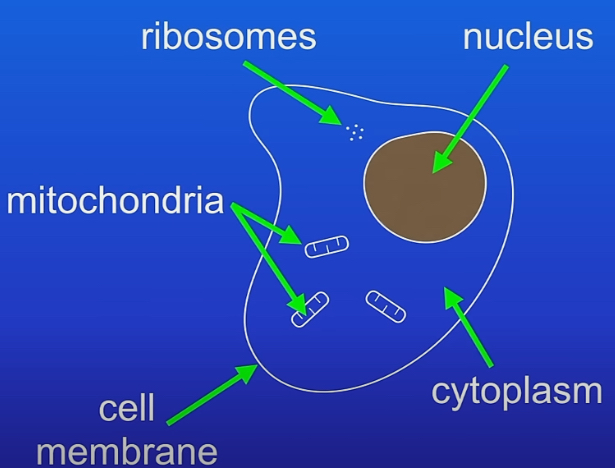
What does an animal cell consist of?
Nucleus
Mitochondria
Cell membrane
Cytoplasm
Ribosomes
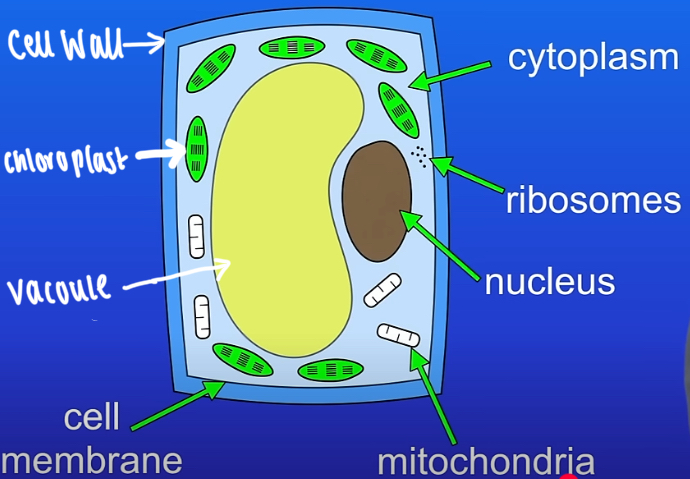
What does a plant cell consist of?
Nucleus
Mitochondria
Cell membrane
Cytoplasm
Ribosomes
Rigid cell wall
Chloroplasts
Permanent vacuole
What does a bacterial cell consist of?
cell membrane
cell wall
cytoplasm
Loop / circular strand of DNA
plasmids
Ribosomes
(Flagella-help swim )only in some
Function of nucleus
Contains genetic material & controls the activities of the cell
Function of mitochondria
-site of aerobic respiration
-releases energy for the cells.
Function of cytoplasm
Gel-like substance where most of the chemical reaction happen.
It contains enzymes that control these chemical reactions.
Function of cell membrane
Holds the cell together and controls what enters and leaves the cells
Function of ribosomes
Site of protein synthesis
- These are where proteins are made in cells
Describe the cell wall in plants and it’s function
Made of cellulose
Gives the plant cell it’s shape and strengthens it.
Describe the permanent vacuole and it’s function
Contains cell sap ( a weak solution of sugars and salts) which helps keep cell turgid
Describe the chloroplasts and their function
Contain chlorophyll which is the site of photosynthesis
Also contains enzymes needed for photosynthesis
Also provides colour green
Animal cell specialisation
Most animals cells are specialised.
This means that they have adaptations which help them to carry out their particular function.
When cells become specialised, scientists call that differentiation.
How are sperm cells specialised to carry out their function?
Function: To join with an ovum (egg cell) in a process called fertilisation. During fertilisation the genetic information of the ovum and the sperm cell combine.
Adaptations:
Contain only half the genetic information of a normal adult cell.
Sperm cells have a long tail = allows them to move & swim to the ovum.
Streamlined head = swim to the ovum.
full of mitochondria = release energy in respiration→needed for the tail to move
The outer layer of the sperm head (acrosome) stores digestive enzymes= can break down the outer layer of the ovum.
How are nerve cells specialised to carry out their function?
Function: To send electrical impulses around the body.
Adaptations:
Long axon= carries electrical impulses from one part of the body to another, to cover more distance
Axon is covered in myelin=insulates the axon and speeds up the transmission of nerve impulses.
Synapses=(The end of the axon)= junctions which allow the impulse to pass from one nerve cell to another.
Dendrites=increase the surface area so that other nerve cells can connect more easily.
How are muscle cells specialised to carry out their function?
Function: To contract (get shorter) quickly
Adaptations:
Contain protein fibres which can change their length
When muscle cell contract these protein fibres SHORTEN=decreasing the length of the cell
Have lots of mitochondria = transfer energy needed for contraction.
Work together to form =muscle tissue
They can store glycogen( a chemical that can be broken down into glucose and used in cellular respiration).
Plant cell specialisation
Most plant cells are specialised.
They have special adaptations which help them to carry out their particular function.
When cells become specialised =that process is called differentiation.
Specialised root hair cell + Function:
Function: Absorbing water and minerals
Adaptations:
Has root hairs = increase surface area available so it can absorb water +dissolved minerals
No chloroplast as underground →no photosynthesis →helps cells keep energy
Thin cell wall=short diffusion path for water
Large permanent vacuole = speeds up the movement of water by osmosis.
Many mitochondria =provides energy needed for active transport of mineral ions against the concentration gradient
Xylem Cells Specilaised+ function:
Found in: Pants stem
Form:Long tubes
Function: To carry water and dissolved minerals ions from the roots to the leaves.
Adaptations:
No end walls = broken down ends to form long tube → water + dissolved minerals can easily flow through.
Hollow tubes →NO internal organelles→water & dissolved minerals flow through more easily.
Thick walls which Contains lignin:→ strengthens and waterproofs the wall cells (but as cell walls are covered in lignin) =causes xylem cells to die
phloem Specialisation + its function
Functions: To carry dissolved sugars up+down plant & from the leaves to other parts of the plant (consist of 2 diff types of cells)
Adaptations:
(Cell 1)Phloem vessel cells =very few sub cellular structures to help the flow of substances.→no nucleus & limited cytoplasm
(Cell 2)Sieve plates = broken cell wall that have pores →Allows dissolved sugars to move through cell interior
companion cell connected by pores=provide energy for active transport of sugars .(mitochondria in comp. Cel )
REQUIRED PRACTICAL ; MICROSCOPY
PREPARE THE SLIDE:
1)Using forceps peel of the epidermal layer of an onion
2)Add a drop of water onto a slide using a pipette and place the tissue onto the slide ensuring it lays flat
3)Add 2 drops of iodine solution to stain the cells
4)Gently place the coverslip on top ensuring there’s no air bubbles
USING THE MICROSCOPE:
5)Place the slide onto the stage of the microscope and use stage clips to hold down
6) select the lowest power objective lens ,some it’s 4*
7)look from the side and use ‘coarse adjustment knob’ to raise the stage until the cover slip touches the objective
7)Look through the eyepiece and slowly turn the ‘coarse adjustment knobl’ to move the ‘stage’ until it comes into view and focuses
8)Use ‘fine focusing knob’ to bring cells into a clear focus
9)Switch to a ‘higher magnification’ for more detail
10) work out total magnification =‘Eye piece lens’ * ’objective lens’
OBSERVING & DRAWING:
12)Use a pencil to make a clear, labelled drawing of some of the cells & include magnification scale
13)Mag. Scale = place a clear ruler over the stage =measure the diameter it in ‘millimetres’ and include the magnification
OPTICAL MICROSCOPE CAN ONLY SHOW LIMITED DETAIL :no ribosomes etc
Calculate the Total Magnification
Total Magnification = Eyepiece Lens Magnification × Objective Lens Magnification
E.G: ‘Eye piece lens’ magnification= 10x
‘Low-power objective lens’ magnification=4x. 10×4 = total mag.=40x
How to calculate real size of cell based on a microscope
Actual Size of Cell = Image Size ÷ Magnification (use a ruler to measure the image size in mm, convert to micrometers if needed)
Dis/advantages of light microscopes
They have limited magnification -only see larger organelles
Limited resolution (image is blurred)- limits to see smaller structures can’t see ribosomes etc
Advantages:
affordable (some)
Portable
Easy to use
What is Resolution?
To distinguish between 2 separate points of an object
measure of how detailed the image is.
Dis/Advantages of electron microscope
Greater magnification (than light microscopes)-smaller structures & details
Greater resolution (than light microscopes)-detailed images see ribosomes etc
Dis:
expensive
Large not portable
Lots of training required
What are chromosomes made out of?
The molecule DNA?
What are chromosomes?
Long molecules of DNA found in the nucleus of the cell.
Carry genes that control the characteristics of the organisms
How many of each chromosome do body cells contain?
Two-they’re paired →one chromosome from mother & one chromosome from father
How many pairs of chromosomes do human body cells contain?
23
Which certain cell has chromosomes which are not paired?
Gametes- They have 23 single chromosomes
What do chromosomes carry?
Genes- which determine many of our features
Cell division by mitosis
The DNA replicates to form two copies of each chromosome. The cell also grows and copies it’s internal structure, such as mitochondria and ribosomes.
Then (mitosis takes place.) One set of chromosomes is pulled to each end of the cell. The nucleus also divides.
The cytoplasm and cell membrane divide to form two identical daughter cells.
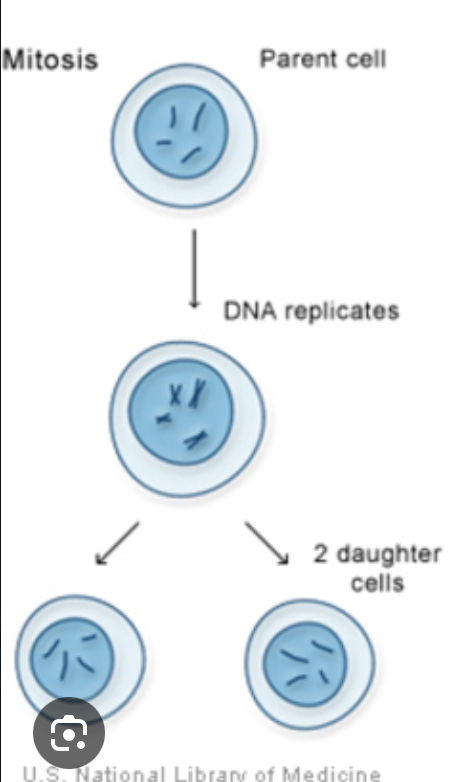
What is the cell cycle?
When a cell divides in a series of stages.
Functions of mitosis
growth and development =increases numbers of cells →allows cells to grow
Repair = replaces damaged/ dead cells with new identical ones
Asexual reproduction.= to reproduce without involvement of gametes
What is a stem cell?
A undifferentiated cell that has the ability to develop+differentiate into many different types of cell
What is cell differentiation?
The process where a cell chnages to become specialised for its function
(Undergoes changes in structures/function/gene expression allowing it to develop into a specific type)
What are embryonic stem cells?
Stem cells found early in human embryos. And have ability to differentiate into any type of body cellS
What can embryonic cells be used for ?
treat medical conditions by replacing damaged cells (e.g spinal cord injuries)
What are issues with embryonic stem cells ?
ETHICAL ISSUES ;
Some object the use of it →for ethical / religious reasons
Using embryos in research raises concerns about destroying life
Where can adult stem cells be found?
Bone marrow
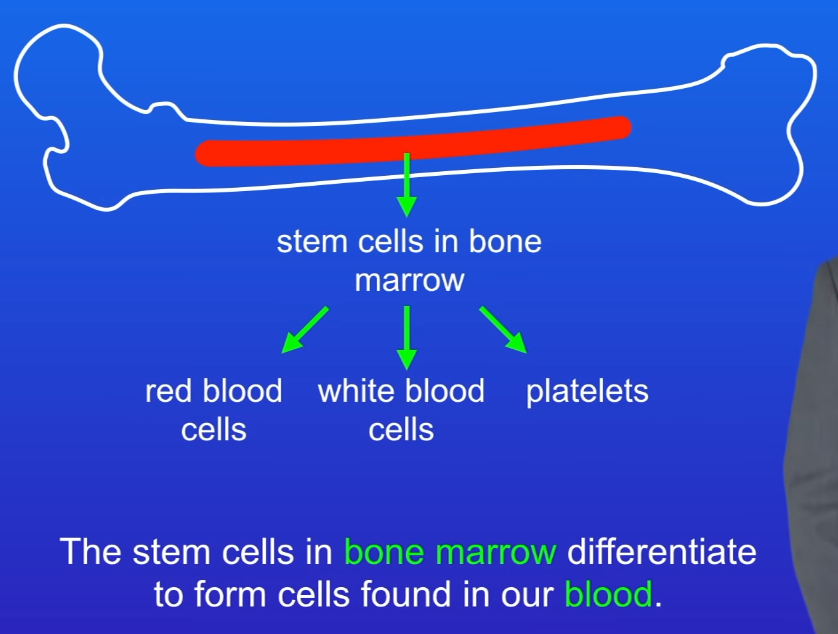
what is a bone marrow stem cell ?
Example of an Adult stem cell that can differentiate into CERTAIN types of cells→limited e.g blood cells
What is leukaemia?
A cancer of the bone marrow.
How does medicine use bone marrow? (Transplants)
Stem cells transferred from the bone marrow of a healthy person can replace faulty blood cells in the patient who receives them.
1) patients existing bone marrow is destroyed using :RADIATION/CHEMOTHERAPY
2)Patient receives a transplant of bone marrow from donor
3)Stem cels in bone marrow DIVIDE & FORM NEW bone marrow —also DIFFERENTIATE & form BLOOD cells
Problems with bone marrow transplant
Donor must be compatible with the patient — otherwise white blood cells produced by the donated bone marrow could attack the patient’s body.
Viruses can be passed from the donor to patient.
Procedure can be painful
Two ways stem cells can be used in medicine
Bone marrow transplant
Therapeutic cloning (embryo )
What’s Therapeutic cloning and the it’s process ?
DEF: A process that creates an embryo with the same genes as a patient
An embryo is produced with the same genes as the patient.
The nucleus is removed from one of the patient’s body cells.
This nucleus is inserted into an egg cell that has had its nucleus removed
egg cell develops into an embryo with the patient’s DNA.
Stem cells from the embryo are genetically identical to the patient.
These stem cells can be transplanted without rejection by the immune system.
Once transplanted, the stem cells can differentiate into specialised cells to replace damaged or non-working tissues/cells
What can therapeutic cloning be used for?
medical conditions:
diabetes
Spinal cord injuries
Paralysis
Heart disease
Parkinson’s disease
Disadvantages of therapeutic cloning
Ethical concerns - wrong to create & destroy
Expensive & time -consuming - costly & not widely available .
Spread of infection
PLANT STEM CELLS - What is the function of meristem tissue in plants?
Produce new cells by mitosis which can Differentiate into any type of plant cell, at any point of plants life.→allows plant to grow
(Roots & buds contain meristem tissue)
What can meristem tissue be used for?
Cloning plants- Can produce genetically identical plants → quickly and economically.
Preserving rare species - Cloning plants to protect them from extinction.
Cloning Crops with special features - cloned to produce large numbers of identical plants for farmers e.g Disease resistance
What is diffusion?
The spreading out of substances/particles resulting in a net movement from an area of high concentration to an area of low concentration.
Diffusion of O2 and CO2 (in gas exchange )
Cells need oxygen for respiration → happens in mitochondria.
Oxygen from lungs diffuses into bloodstream →cells are then surrounded by blood with a high concentration of oxygen
Less oxygen inside cell as it’s being used for respiration
Creating a CONCENTRATION GRADIENT : high oxygen outside cell → low oxygen inside cell
So→oxygen diffuses into cell
inside the cell →Oxygen used in respiration to release energy → produces CO2 as waste product
Now a higher concentration of carbon dioxide inside cell & low outside → carbon dioxide diffuses out of cell into the blood
What is urea?
A waste product formed in the liver when excess amino acids are broken down
Diffusion of urea
diffuses from out of the liver cells → high concentration
into the blood plasma →low concentration
is excreted by the kidneys.
Factors that affect the rate of diffusion and how?
1)DIFFERENCE IN CONCENTRATION GRADIENT =The greater then concentration gradient, the higher the rate of diffusion.
2)TEMPERATURE = The higher the temperature, the greater the rate of diffusion, as the particles have more kinetic energy and are moving faster.
3)SURFACE AREA = The larger the surface area (of the cell membrane), the greater the rate of diffusion.
What is a single-celled organism?
made up of just one cell which carries out all functions of life like respiration etc
Example is : amoeba / bacteria / paramecium
What is the surface area to volume ratio?
-compares the surface area of a cell (outer layer) to its internal volume (inside the cell )
Steps to calculate Surface Area to Volume Ratio (SA:V)
Steps to Calculate Surface Area to Volume Ratio (SA:V)
1. Find the Surface Area (SA)
For a cube, use the formula:
Surface Area = 6 × (side length) 2
Each cube has 6 faces, and the area of one face is side x side.
2. Find the Volume (V)
For a cube, use the formula:
Volume = (side length)3
Multiply the length, width, and height (since a cube has equal sides).
3. Calculate the Surface Area to Volume Ratio (SA:V)
SA: V= Surface Area / Volume
EXAMPLE:Let's say we have a cube with a side length of 2 cm:
1. Surface Area:
6x (2x2) =6 x 4 = 24 cm?
2. Volume:
2x2 x 2 = 8 cm'
3. SA:V Ratio:
24 / 8 =3 : 1
This means for every 1 unit of volume, the cube has 3 units of surface area.
What happens to the SA:V as a cell increases in size
Decreases → making it harder to exchange materials in & out of cell
Why is single-called organisms having a large SA:V important ?
allows more efficient diffusion of substances e.g O2 & nutrients into cell & waste products OUT →for organisms survival
Problem of having a low SA:V ratio on multicellular organisms.
SLOWER DIFFUSION RATE : Less surface area for substances to diffuse across →BUT lot of cells inside in need for substances (O2/nutrients)
INEFFICIENT TRANSPORT: not enough surface area for substances & waste to diffuse in & out of organism quickly & efficiently→ can affect cell survival
METABOLIC RATE: multicellular organisms have high metabolic rates →need exchange substances more rapidly → low one makes it harder to do that
NEED → Transport systems (Circulatory system ) & Specialised exchange surfaces (alveoli )
How have animals adapted to overcome having a low Surface Area : volume ratio ?
1)Specialised Exchange Surfaces →Increases surface are available for diffusion EG: lungs & mammals
2)Transport systems → Help move substances/ gases around the body quickly ( E.G Circulatory system)
Why are surfaces and organ system specialised in multicellular organisms?
For exchanging materials → allow sufficient molecules to transport into & out of cells for organisms needs
What factors increase the effectiveness of an exchange surface?
Large surface area
Thin membrane→ Provides short diffusion path
Efficient blood supply (in animals)
Ventilation ( in animals for gaseous exchange)
How are small intestines adapted for efficient gas exchange?
Villi’s → tiny little projections → increase the surface area for absorption
Micro -villi’s → Even Smaller projections→ Further Increases Surface
Thin Walls → One cell thick → Reduces distance for diffusion
Good blood supply → Assist with quick absorption & Quickly transport away
How are the lungs adapted for efficient gas exchange (in mammals)?
Alveoli → Small Air sacs →increase surface area
Thin walls → one cell thick →allows gases to diffuse
Large surface area → Many alveoli → provide more space for gas exchange
Good blood supply → Maintains concentration gradient → O2 and CO2
How are roots adapted for efficient water and mineral absorption?(Exchange in plants)
Root hairs → increases surface area → water & mineral absorption
Thin Cell walls → water passes easily into root cells
Large Surface Area → Ensures Efficient uptake of Water & minerals → from soil
Describe how the gills in fish are adapted for exchanging materials.
Gill Filaments → thin plates → Gives large surface area → where gases passes in & out of blood
Lamellae → Covers gill filaments →further increases surface area → has Lots of blood capillaries →speeds up diffusion
Countercurrent Exchange →Water flows over gills in one direction → blood flows through the gills capillaries in the opposite direction → maintaining steep gradient for oxygen absorption (More O2 in water than blood )
Thin membrane → allows gases to diffuse quickly between water & blood
Good blood supply → Continually removes oxygenated blood → aid in maintaining the gradient
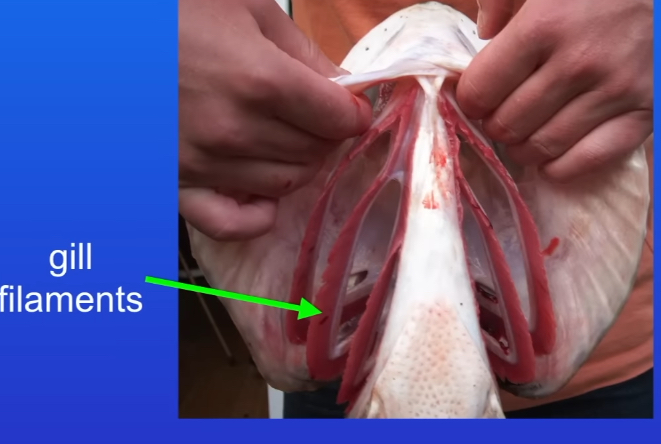
What is osmosis?
The diffusion of water from a dilute solution to a concentrated solution through a partially permeable membrane.
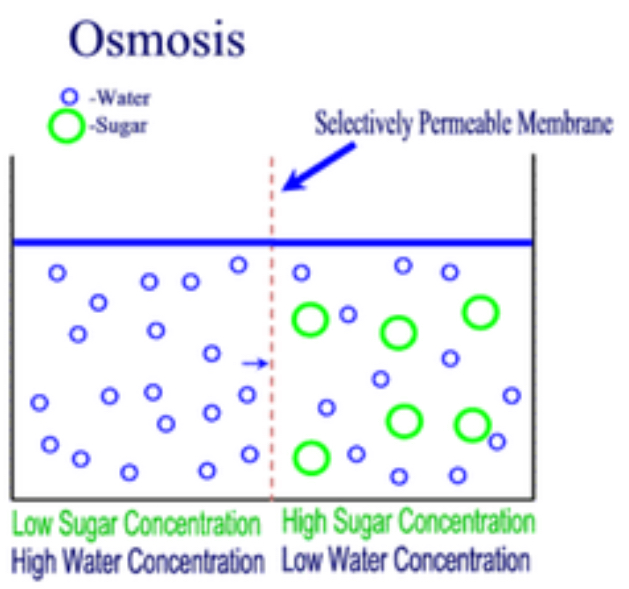
What’s a partially permeable membrane?
A membrane than only allows some molecules to pass through.
Osmosis of animal cells
Cytoplasm → relatively concentrated solution so if → animals cell placed into water→ osmosis will takes place.
In hypotonic conditions →Water moves by osmosis from →outside the cell to inside the cell.→ causes cell to swell & may burst (as no cell wall to prevent)
In hypertonic conditions → water moves out of the cell by osmosis → cel shrinks
In isotonic conditions → Water moves in / out equally → cell stays same
Osmosis of plant cell
Cytoplasm →relatively concentrated solution → if plant cell is placed into water→ osmosis will take place.
Hypotonic Solution → Water moves into cell (more water outside cell )by osmosis →Cell becomes turgid (doesn’t burst due to cell wall)
Isotonic Solution → Water moves in / out equally → Remains normal (Flaccid )
Hypertonic solution →Water leaves cell by osmosis → Vacuole shrinks
Effect of osmosis on plant tissue (REQUIRED PRACTICAL)
Peel potato → the potato skin can affect osmosis.(acts as a semi-permeable barrier)
Use a cork borer to produce three cylinders of potato with same diameter
Use scalpel → trim the cylinders to the same length (around 3cm).
Measure length & initial mass of each cylinder → using a ruler & balance
Now add each cylinder into a test tube→in first test tube Add 10cm³ of 0.5 molar sugar solution
Add 10cm³ of 0.25 molar sugar solution in the second test tube.
Add distilled water into the third test tube. (distilled water contains no dissolved substances which could affect the rate of osmosis)
Leave the potatoes overnight and allow osmosis to take place.
then→ remove potato cylinders & gently blot dry with paper towel to remove any excess solution which could affect mass.( Also don’t press too hard so that you don’t force water out of cells).
Measure the lengths & mass of the cylinders again & calculate the % change using the formula. → record measurements in table
Plot a graph of change in mass (in g) against concentration of sugar solution
Plot a graph of change in length (in mm) against concentration of sugar solution
percentage change formula
FINAL MASS - INITIAL MASS / INITIAL MASS X 100
What does it mean when potato has no change in mass
Concentration of water inside and outside the cell was the same so no overall osmosis took place.
Safety precautions taken during osmosis practical:
1)Handle the scalpel/knife carefully when cutting potatoe cylsinders
2)clean up any spills Immediately
3)ensure all equipment is used appropriately to prevent accidents
What is active transport?
Movement of substances from a more dilute solution to a more concentrated solution →against the concentration gradient→ using energy from respiration.(non-passive)
Difference between diffusion and active transport
DIFFUSION :
Particles move down the concentration gradient
Doesn’t require energy from respiration = passive
ACTIVE TRANSPORT:
Particles are moved against the concentration gradient
Does require energy from respiration = non-passive
What are 2 Example of active transport?
1) In plant cells - Root Hair cell
2)In animal cells - Lumen (cavity(hollow space) in the small intestine)
Active transport in the Lumen
Lumen - the cavity of the small intestine where food is digested
After digestion →concentration of nutrients(glucose / amino acids) can be lower in the lumen then in the blood
To absorb these nutrients, active transport is required
Moves glucose from lumen into blood stream→ against the concentrated concentration → using mitochondria
it’s carried around body for →respiration / stored as glycogen in liver + muscles
Active transport in Root Hair Cell
-Root hair cells are found on the surface of plant roots →absorb mineral ions by active transport
- concentration of mineral ions (e.g nitrates/magnesium ) in the soil is often lower than inside root hair cells
-so mineral ions must move→ against the concentration gradient → from low (soil) to high (inside the root)
-requires energy - diffusion wouldn’t work
TOPIC 2 : ORGANISATION
What is a Tissue?
A tissue is a group of cells with a similar structure and function.
What is an Organ?
a group of tissues that work together to perform a specific function e.g. →the stomach contains muscle tissue
What are Organ Systems?
Organs grouped together to perform particular function
Why are food molecules digested & what are the nutrients?
They are too large to be absorbed into the bloodstream.
Food contains 3 main nutrients: carbohydrates (eg starch) , protein and lipids (fats)
What happens during digestion.
Large food molecules are broken down into small molecules by enzymes. These small molecules can then be absorbed into the bloodstream.
Now the products of digestion are then used by the body to build new carbohydrates lipids and proteins.
Some of the glucose produced is used in respiration.
The Digestive system
Mouth→ Food is chewed . Enzymes in the saliva →amylase →begin to digest the starch into smaller sugar molecules.
Oesophagus -moves food down to stomach
Stomach→, Protease enzymes begin to digest proteins. The stomach also contains →hydrochloric acid → helps the enzymes to digest proteins.+ kills bacteria
The food spends several hours in the stomach→ muscular churning of stomach muscles turns the food into a →fluid increasing surface area for enzymes to digest.
fluid now passes into→ small intestine and at the same time, PANCREAS & liver releases enzymes
Pancreas→releases enzymes which continue digestion of starch and protein → they begin the digestion of lipids.
liver →releases bile (stored in gallbladder)→ helps speed up digestion of lipids as it emulsifies fats. → also neutralises the acid released from stomach.
The fluid makes its way down the rest of the small intestine.
walls of the small intestine →release enzymes to continue digestion of proteins and lipids. → the small food molecules produced by digestion are absorbed into bloodstream by diffusion or active transport.
Now the fluid makes it’s way through → large intestine where water is absorbed into the bloodstream.
Finally the faeces is released from the body. From →anus/rectum
definition of enzymes
Biological catalysts that speed up chemical reactions in living organisms without being used up..
What is the structure & function of enzymes
STRUCTURE:
Large protein molecules.
They have a groove on their surface → the active site.(specific)
The active site is unique →where specific substrates (reactant) binds to.
FUNCTION: → Catalyse specific reactions in the body :
Break down large molecules (e.g digestion )
Building up molecules (e.g making proteins from amino acids )
The lock and key theory
The enzyme = lock
the substrate = key
enzymes are specific & have a specific active site that only fits one specific substrate → like lock & kry
When substrate binds an enzyme → enzyme -substrate complex forms
Then enzyme can catalyse the reaction → products are released & the enzyme can be reused
If temperature gets too high or pH levels are extreme then the active site denatures which changes shape
What do digestive enzymes do?
Digestive enzymes convert large food molecules into small soluble molecules that can be absorbed into the bloodstream.